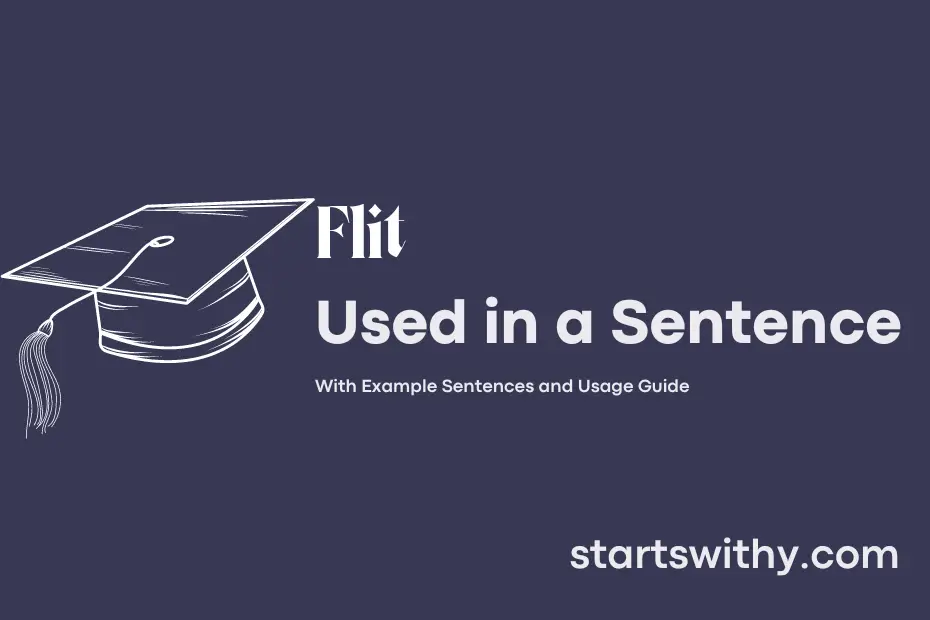Have you ever wondered what the word “flit” means in English language? To “flit” is to move swiftly and lightly from one place to another, often with a sense of quick and graceful movement.
When someone flits, they are typically moving in a quick and darting manner, almost as if they are floating or fluttering. This word can be used to describe someone who is moving from one spot to another with ease and a certain level of elegance.
7 Examples Of Flit Used In a Sentence For Kids
- Butterflies flit from flower to flower.
- Birds flit from tree to tree in the garden.
- Fairies flit around the magical forest.
- Colorful dragonflies flit over the pond.
- Bees flit among the blooming flowers.
- Fireflies flit around in the dark night.
- Hummingbirds flit around the feeder for nectar.
14 Sentences with Flit Examples
- Flit between study groups to get multiple perspectives on the topic.
- Make sure to flit between different reference materials for a comprehensive research paper.
- Flit through your class notes before exams to refresh your memory.
- It’s common for college students in India to flit between different career options before making a decision.
- Don’t be afraid to flit between different extracurricular activities to find what suits you best.
- Flit between theory and practical applications to have a well-rounded education.
- Flit between different study spaces to keep your environment fresh and stimulating.
- Take time to flit between different study techniques to find what works best for you.
- Flit between different time management strategies to optimize your schedule.
- College students often flit between different social circles as they navigate through their education.
- It’s important to flit between different perspectives in order to develop a well-rounded worldview.
- Flit between different study apps to find the one that helps you stay organized.
- College life in India can be a whirlwind as students flit between classes, assignments, and social activities.
- Flit between different study buddies to find a productive and motivating partnership.
How To Use Flit in Sentences?
Flit can be used in a sentence to express quick or nimble movement. For example, “The butterfly will flit from flower to flower in the garden.” In this sentence, flit is used to convey the swift and darting motion of the butterfly as it moves around the garden.
When using flit in a sentence, it is important to ensure that the context conveys a sense of lightness or quickness. For instance, “She would flit around the room, her laughter filling the air.” Here, flit is used to describe the woman’s swift and lively movements as she moves about the room.
To use flit effectively in a sentence, consider the pace and energy of the action you are describing. Flit is typically used to evoke a sense of rapid, fleeting movement or activity. For example, “The hummingbird would flit from one feeder to another, pausing only briefly to sip nectar.” In this sentence, flit emphasizes the bird’s quick and agile movements as it visits different feeders.
In summary, flit is a versatile verb that can add a touch of speed and agility to your descriptions. Experiment with using flit in different contexts to convey a sense of lightness and quickness in your writing.
Conclusion
In this article, examples of sentences with the keyword “flit” have demonstrated its usage in describing fleeting movements or actions. The word “flit” is often used to depict quick or light movements, as seen in the phrases like “The butterfly would flit from flower to flower” or “She could feel the moments flitting by as she waited anxiously.” These sentences showcase how “flit” can convey a sense of rapid and fleeting motions in a concise manner.
Overall, sentences with “flit” effectively capture the transient nature of movement or actions, making it a useful word for describing quick, ephemeral behaviors in a vivid and evocative way. By incorporating “flit” in writing, one can add a dynamic element to descriptions and bring a sense of immediacy to the narrative, enhancing the reader’s understanding and engagement with the text.



